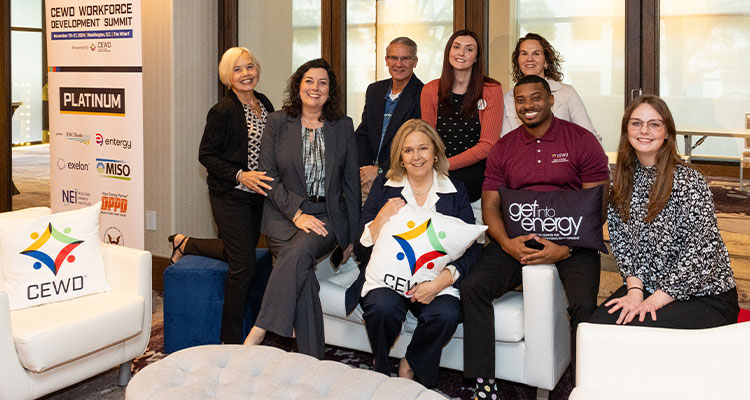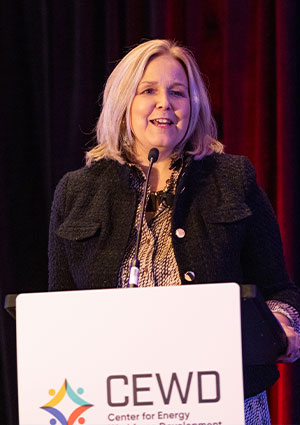
Missy Henriksen, Executive Director, shares how CEWD is working in partnership to strengthen the talent pipeline and create a more direct path from education to energy careers
To begin with, could you share details of your career history and how you came to be Executive Director of Center for Energy Workforce Development (CEWD)?
My background resides in associations, where I’ve united industry leaders for more than 25 years. I am passionate about the outcomes that can be achieved when an industry collaborates, seeing accomplishments that are too great for any company to tackle on their own. I’ve been in my current role for five of those years. Ironically, I started the workforce development programming with my last employer, a trade association, and used Center for Energy Workforce Development as a model to influence thinking around how to bring an industry together on the people side of the business. I am proud to be in this role at such a pivotal time in the evolution of the industry.
What does your day-to-day role involve and what aspects do you particularly enjoy?
As with many jobs, there is no typical day-to-day script. Each day brings new opportunities in our efforts to ensure a skilled, diverse energy workforce. CEWD has expanded its wings lately, so our work is taking us into new areas including educating policymakers about needs and opportunities for the energy workforce, driving greater visibility of energy careers, partnering with organizations that can increase visibility of energy careers, and having energy curriculum adopted in high school and post-secondary classrooms around the country. This last area, in particular, is all-encompassing as the adoption of the new national Energy and Natural Resources Career Cluster has created a watershed opportunity for industry to connect with ten million career and technical education students – many of whom are ideal candidates for energy careers – in ways we haven’t been able to in the past.
The energy industry faces an enormous workforce gap, with 32 million jobs to fill over the next decade. What are the primary drivers of this labor shortage, and how is CEWD addressing them?
An aging workforce, growing power needs, the rise of new energy technologies, and significant investments from the current and prior administration are some of the key factors driving the labor shortage. The industry’s increased workforce needs are coming at a time when there are too few people to do all of the work in America, with millions of jobs unfilled on any given day. The strong economy, decreased international migration, and the rise of the gig economy all contribute to the tight labor market that can be observed all around us.
Complicating the tight societal hiring conditions, many career seekers and students lack awareness of the opportunities available in the energy sector and how to enter the industry, creating the ultimate perfect storm of challenge – and opportunity.
CEWD is working to address the historic hiring demands before us by meeting people where they are – whether in the classroom, job training programs, or their communities. We develop curriculum, share resources, and push career awareness initiatives like Get Into Energy and Troops to Energy Jobs to help students and career changers navigate pathways into the industry.
With Gen Z expected to comprise a third of the workforce by 2030, what are the most effective ways to engage this generation and reshape their perception of careers in energy?
Gen Z is purpose-driven, yet many don’t realize the energy industry offers careers that align with their values. They are also looking for customized opportunities that speak to their interests. To engage this generation, the industry must highlight its role in evolving energy opportunities, innovation, and environmental progress. CEWD’s initiatives showcase jobs across the industry, making all jobs – those in business, technical roles, and skilled trade positions – more visible and accessible. We often say that we promote jobs that require a PhD to a GED and everything in between.
Beyond awareness, hands-on experience and career-connected education are key. Many young workers are open to energy careers if they see a clear path forward. Sometimes, the younger generations do not realize certain professions, like welders and electricians, can work within the energy industry – it’s our job to help those in their network (educators, teachers, community leaders, etc.) help them navigate the options and connect the dots.

Many industries are competing for the same skilled labor pool. How can the energy sector stand out as a top career choice for young talent?
The energy industry offers exceptional benefits – job security, potential for career growth, above-average pay, and more. The energy industry provides diverse and rewarding careers. From skilled trades to corporate roles, energy professionals help power communities, drive sustainability, and advance new technologies.
With 61 percent of Gen Z interested in (energy) jobs but many unsure how to access them, the industry has an opportunity to lead. CEWD and its industry partners are working to bridge this gap by raising awareness, expanding training opportunities, and ensuring young talent sees a future in energy careers. Clear and accessible avenues into the industry can help it position itself as a top choice for the next generation. And with the momentum of the energy evolution, our industry is here to stay.
CEWD recently partnered with SkillsUSA to support the rollout of the new Energy and Natural Resources Career Cluster. How will this initiative enhance energy education and workforce development?
The launch of the Energy and Natural Resources Career Cluster is a major step forward in workforce development, providing educators with a dedicated framework to introduce students to energy careers. The adoption of the new Energy and Natural Resources Career Cluster means students, especially the ten million in career and technical education, can more easily learn key industry disciplines and understand how to take the first step into an energy career – that is if they are provided the opportunity.
Among the many ways CEWD connects with educators is by partnering with SkillsUSA to help strengthen the rollout efforts by expanding outreach to SkillsUSA’s network of more than 413,000 career and technical education students and teachers. This collaboration introduces energy-focused career competitions and hands-on learning experiences that help students build the skills needed for success in the field and educators see the importance of adopting an energy curriculum in the classroom. Beyond the conference, CEWD and SkillsUSA will continue working together to integrate energy education into classrooms and career pathways, increasing awareness of industry opportunities.
What role does hands-on learning play in attracting young professionals to the energy industry, and how will the interactive experiences at the SkillsUSA National Leadership & Skills Conference help spark interest?
Hands-on learning is essential to attracting young professionals, helping them connect classroom knowledge to real-world careers. Interactive experiences allow students to see themselves in energy roles, understand the skills required, and develop interest in a career that powers their communities.
At the SkillsUSA National Leadership & Skills Conference, CEWD will engage directly with thousands of students through career competitions and the Try-a-Skill booth at TECHSPO, where they can experience energy-related tasks firsthand. These immersive activities introduce students to a multitude of careers and build confidence in their ability to succeed in the field.
The energy sector is evolving rapidly, with advancements in renewable energy, grid modernization, and emerging technologies. How does the new career cluster prepare students for the industry’s future workforce needs?
The energy industry is evolving, creating demand for a workforce skilled in renewable energy, grid modernization, and emerging technologies. The Energy and Natural Resources Career Cluster helps educators introduce students to these careers – and others – and provides clear entry points into the industry.
Many Gen Z job seekers are interested in sustainability but lack information about energy career options. Nearly 60 percent of teachers in an NPR/Ipsos study reported feeling unprepared to teach climate-related topics. The new career cluster, along with CEWD’s Energy Industry Fundamentals (EIF) 2.0 curriculum, helps bridge this gap by equipping educators with tools to confidently teach all energy career pathways.
Beyond SkillsUSA, what other partnerships or programs is CEWD developing to strengthen the talent pipeline and create a more direct path from education to energy careers?
CEWD thrives on partnerships. Beyond SkillsUSA, we work with organizations like the National Urban League and UnidosUS to reach underrepresented communities, translating resources into Spanish and broadening career awareness. Partnerships with DECA introduce younger students to energy careers, while our State Energy Workforce Consortia and industry partners support both local and national career awareness efforts. We are collaborating with FFA and the National Council for Agricultural Education to connect with educators as well.
We also collaborate with labor and industry groups to ensure a well-prepared workforce. The majority of CEWD’s work supports career seekers by providing information and training to help them enter the industry, creating clear, accessible routes for future energy professionals.
Many students and educators may not fully understand the variety of career opportunities available in energy. How can companies and industry leaders help drive awareness at the high school and college levels?
Companies play a critical role in raising awareness of energy careers. CEWD’s Meet the Moment Campaign is bringing the industry together – because no single company can do it alone. To truly make an impact, energy companies must get involved, working collectively with CEWD to introduce students and career changers to the opportunities available in energy. Through partnerships with schools, workforce programs, and community organizations, companies can help connect future talent with clear career pathways.
Workforce diversity is a major priority across industries. How is CEWD ensuring that underrepresented groups have access to energy careers?
The industry has traditionally been a legacy field, but to meet future demands, we need people from all backgrounds bringing fresh perspectives and new ideas. That’s why CEWD is focused on expanding access to energy careers and making sure everyone has a chance to be part of this evolving industry.
Through partnerships with community organizations, we’re reaching people who may not have considered or had access to energy careers before. We’re also working with energy companies, schools, and workforce programs to create clearer entry points into the industry. We’re ensuring a workforce that reflects the communities it serves by increasing accessibility and awareness.
Recruitment is just one piece of the puzzle. What strategies are essential for retaining skilled energy workers and fostering long-term career growth within the industry?
Keeping skilled workers in the industry requires a commitment to their growth. Reskilling and continued education programs help employees adapt to new technologies and advance their careers while staying engaged.
Just as important is creating a workplace where employees feel valued. Competitive benefits, strong workplace culture, and mentorship programs contribute to long-term retention and job satisfaction. Companies that invest in their workforce build a stronger, more resilient team ready for the energy future.
Is there anything else you’d like to mention?
The energy industry spans a wide range of sectors, including oil, gas, hydropower, solar, wind, nuclear, and more. While each sector plays a unique role, they all share a common goal: powering our country. CEWD collaborates across the entire energy industry to raise awareness of career opportunities and help more people discover their place in this essential field.
The Center for Energy Workforce Development (CEWD) is a non-profit consortium of electric, natural gas, nuclear, and renewable energy companies, and their associations, committed to the development of a skilled, diverse energy workforce.